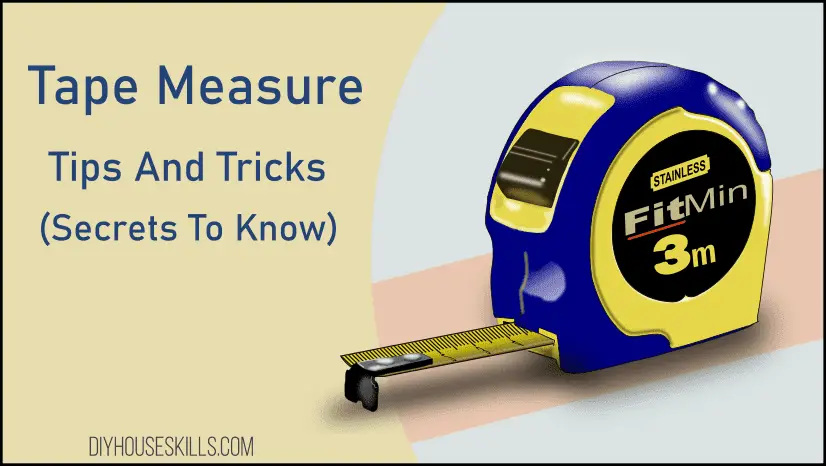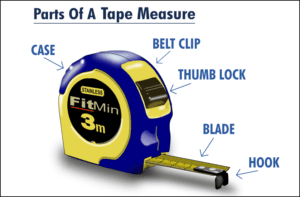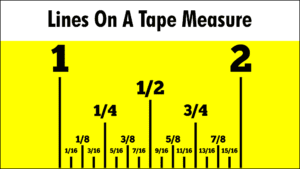Most people have used a tape measure at some point in their lives. We commonly use them for simple measurements without thinking too much about them. But tape measures are chock full of features that if we learn about can ensure we use them properly and get accurate measurements.
The tips and tricks of tape measures are features and uses that construction professionals and others know about but the average user may not. I’ll break down and explain each part of a tape measure so you’ll be using one like a pro too.
1) Why Is The Tape Measure End (Hook) Loose?
- The end or hook is loose on purpose.
- The hook is designed to be able to slide or move along it’s rivets exactly a 1/16 of an inch.
- The hook is 1/16″ thick.
- The tape measure is actually 1/16″ short.
2) What Is The Slot In The Hook For?
- The slot is called a nail and screw grab.
- The slot allows you to place the hook over a nail or screw head to hold it in place. Then you can take your measurement.
3) Why Is There A Serrated Edge On the End Or Hook?
- This is a simple tool to scribe or etch a mark on the surface.
- You can use the serrated edge instead of a pencil if one is not handy.
4) Why Is A Tape Measure Curved?
5) Why Does A Tape Measure Have A Diamond On It?
- These marks are called ‘truss marks’.
- The marks are commonly shown for special engineered floor trusses that use this spacing.
- They are stronger or can support more weight than traditional lumber and so can be spaced wider distances.
- This allows you to have 5 of these trusses per 8 feet exactly. Traditional lumber is spaced at 16″ or 24″ segments which give even spacing per 4 feet.
6) Use The Base Length In Your Measurements
- The base of the tape measure lists the length of it.
- This is handy if measuring an inside length.
- Add the length of tape to the length of the base for a total distance.
Parts Of A Tape Measure
- Blade – The blade or tape is the working part of the tape measure. It has measurements printed along it’s length.
- Hook – The hook is attached to the blade at it’s end. It is used to assist in holding the blade in place.
- Thumb Lock – The thumb lock holds the blade in an extended position for taking measurements.
- Case – the case simply houses all the internal components of the tape measure.
- Belt Clip – One side of the tape measure has a belt clip to attach and carry purposes.
Brief History Of The Tape Measure
The Smithsonian National Museum Of American History states that James Chesterman (1795-1867), who was a metal worker in England, invented the spring rewinding tape measure. “In 1821 Chesterman received a British patent for a method of using a spring to rewind measuring tapes automatically.“
They also state that a “six-foot-long tape used for commerce must be accurate to within 1/32 of an inch.”
What Are The Lines On A Tape Measure?
The tape measure markings are explained below.
For a tape measure displayed in feet and inches, it is as follows.
- The longest mark between each inch shows 1/2″ as it is halfway.
- The second-largest mark shows 1/4″.
- The next is 1/8″ and finally the shortest is 1/16″.
Conclusion
While it’s true many of us use a tape measure from time to time, not everyone knows all of its secret functionality. These handy functions of a tape measure such as knowing why the hook slides as well as just knowing how to read the markings will make for accurate measurements.
- Self-Watering Gardens for Small Spaces: Grow Big in Tiny PlacesDreaming of a lush garden but only have a tiny balcony? Self-watering garden systems are your answer! Discover how these ingenious planters and DIY setups can help you create thriving green spaces, even indoors. Find top-rated products on Amazon and start growing today! Primary Query: How can I create a thriving garden in a small space using self-watering techniques? Direct Answer: Self-watering gardens are an… Read more: Self-Watering Gardens for Small Spaces: Grow Big in Tiny Places
- How To Conserve Water At Home | How Can I Lower My Water Bill?People in the United States use a lot of water. Most of us take for granted a constant and steady supply of clean fresh water in our homes. As the weather becomes more unpredictable and the climate is producing extreme temperatures, the water tables are falling and general reservoir supplies are becoming more constrained. It’s good news that more and more people are starting to… Read more: How To Conserve Water At Home | How Can I Lower My Water Bill?
- Outdoor Pizza Oven Buying Guide | How to BuyThis article is a guide about selecting and buying the best outdoor pizza oven. Do you love pizza as much as we do? If so, you’ll know that there’s nothing quite like the taste of a fresh, homemade pizza. And what’s the best way to make a fresh pizza at home? With a pizza oven, of course. In this guide, we’ll teach you everything you… Read more: Outdoor Pizza Oven Buying Guide | How to Buy
- Top Stand Mixers on Amazon: Most Wished ForStand mixers are no longer just a want—they are a need in the modern kitchen! Imagine whipping up fluffy meringue, kneading robust bread dough, or creating perfectly smooth cake batter, all at the touch of a button. A stand mixer can bring all these culinary dreams to life and more! The convenience, versatility, and time-saving capabilities of these kitchen powerhouses make them highly sought-after, frequently… Read more: Top Stand Mixers on Amazon: Most Wished For
- Samsung Robot Vacuum Troubleshooting + AdviceSamsung robot vacuum troubleshooting is for anyone experiencing issues with their POWERbot vacuum. Answers to your Samsung robot vacuum problems are covered in my article as I discuss the most common issues users have. Troubleshooting Samsung POWERbot Vacuums Robot vacuum problems can be a real headache. These intelligent devices make life easier when operating as expected. However, when issues arise it can be difficult to… Read more: Samsung Robot Vacuum Troubleshooting + Advice







